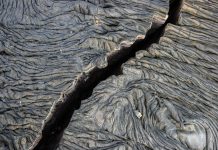We talk to Professor of Polymer Physics Eugene Terentjev, at the University of Cambridge, about the future of plastic
Professor Terentjev is also involved with Cambridge Smart Plastics, a start-up that attempts to funnel leading polymer expertise into revolutionising commodity plastics, accelerating innovation and technology translation.
1. Which potential research application for polymer physics are you most excited about, with Cambridge Smart Plastics?
“At the moment, we are most focused on what we believe is a realistic target of ‘reversible adhesive tape’, developed jointly with a major manufacturer of adhesive and damping tapes. The ‘Holy Grail’ of adhesive technology is a reversible adhesive that leaves no residue on the surface: a system that could have its ‘stickiness’ switched on and off on demand.
“It turns out that liquid crystalline elastomers (LCEs) offer just this functionality, switching its surface adhesiveness off on mild heating, and reversibly recovering it on return to ambient temperature. Our current drive is to maximise the strength of adhesiveness in the ‘on’ state, learn how to incorporate the LCE into the production line of roll-to-roll tape bonding. We hope that in doing this we would also understand the market better, and hopefully find other niches where reversible adhesion is needed.
“The actual reason why this reversible adhesion is a property of LCEs is the anomalously enhanced damping of mechanical energy in these materials. Counter to intuition, it is less the chemical nature of the surface that leads to ‘stickiness’, but more the strong vibration damping of the bulk: e.g. the materials that have high vibration acoustic damping are always sticky, and the ones that are not damping (like glass or solid plastic) are not sticky, even though the surface chemistry may be the same.
“Vibration damping leads to a second raft of applications that Cambridge Smart Plastics develops (although we have to prioritise the effort, being a micro-size company). Currently our main focus in this field (apart from adding the damping feature to the adhesive tapes mentioned above) is a small-volume high-value systems like hand-held vibrating power tools, such as dental drills, or high-end sports equipment such as gold clubs. We work with the Cambridge University i-Teams Enterprise Programme to build contacts with the end-user industry and better fit their needs.
“The longer-term application that we are very excited about, but which is presently on hold because the offered funding pushes us in other directions, is the concept of converting the mixed recycled plastic into a new material that we call ‘Plastic 2.0’ which would have as good properties as the originally produced pure plastics – thus would eliminate the need to produce more (and would motivate the recyclers convert their waste streams into valuable structural material instead of incinerating it).
“The concept relies on the same core technology of Cambridge Smart Plastics, which is the dynamic exchange of covalent bonds between polymer chains, which allows the crosslinked polymer networks (which would normally be regarded as non-recyclable insoluble thermosets) to switch to a plastic flow regime, thus allowing (re)processing – extrusion, injection of blow moulding, 3D printing, and critically: heat welding.
“Especially the welding, which normally has very little success in plastics – but is a key feature of Plastic 2.0, would allow many industrial processes of ‘additive manufacturing’ to come into play for this plastic.”
2. With the liquid crystal elastomers you are working on, you say that there is potential to label them as a new state of matter. Can you tell us more about this?
“Our early review article, with Mark Warner, was called just that: “Nematic elastomers – a new state of matter”. The point is that everyone understands the “states of matter” as: gas – when the material expands uniformly to fill all available volume, liquid – when the material keeps the constant density (i.e. incompressible, unlike the gas), but is free to flow with no resistance to changes of its shape, and solid – when the material (of a constant density similar to liquid) resists elastically to any change of its shape, by what is called the ’shear modulus’. So a block of solid will sit on the desk keeping its shape against gravity, but when molten into a liquid – it will yield to gravity completely and flow into the lowest available cavity, and when evaporated into a gas – will fill the whole room with uniform low density.
“Liquid crystal elastomers occupy a ‘niche’ between solids and liquids. They are certainly ‘solid’ because an LCE would keep its shape as any piece of rubber we are familiar with. But certain geometries of shear deformation encounter no resistance – something we have called the “soft elasticity”, and the material appears (behaves) as liquid for those specific deformation modes.
“Soft elasticity is actually the origin of large mechanical damping of LCEs – because deformations in these modes are only resisted by internal viscous dissipation, and lead to the loss of elastic energy travelling through such a medium. And, of course, the adhesion that is the consequence of enhanced damping, is also the result of this soft elasticity, or the ‘new state of matter’ feature.”
3. Following on from that, what future do you see for photo-actuation in particular? I know artificial muscles are in their early stages, but the sci-fi-esque possibilities for healthcare are really interesting.
“Reversible mechanical actuation is a very spectacular feature of LCEs; it’s mostly induced by heating/cooling cycles, but LCEs could also be made sensitive to light and e.g. uniaxially contract on illumination (and expand back in the dark). We have dreamed of artificial muscles for over 20 years, but so far this is not a realistic prospect for muscle action, for several reasons – for instance, it is difficult to provide local stimulus of high enough intensity, the mechanical response is often slow (good for adaptation, but less useful for fast muscle action), and until recently it was difficult to produce LCE in relevant shapes and in sufficient strength to make a useful large-scale application.
“For these reasons, Cambridge Smart Plastics is not pursuing commercialization of LCE actuation, even though we have various long-distant ideas. This research is still in the academic exploration stage and is done in our Cambridge University laboratory. Here we develop super-strong LCE double networks, learn to 3D print and extrude thin aligned LCE filaments and weave textile from them, or explore large-scale devices such as our recent work on Heliotracker.
“For instance, we hope that the artificial muscle could be assembled from a bundle of LCE filaments, much like the actual muscle build of fibres, because it’s much faster to deliver the stimulus to a very thin LCE object (the Heliotracker takes many minutes to respond to the change of light conditions because its LCE actuators are thick and strong).”











